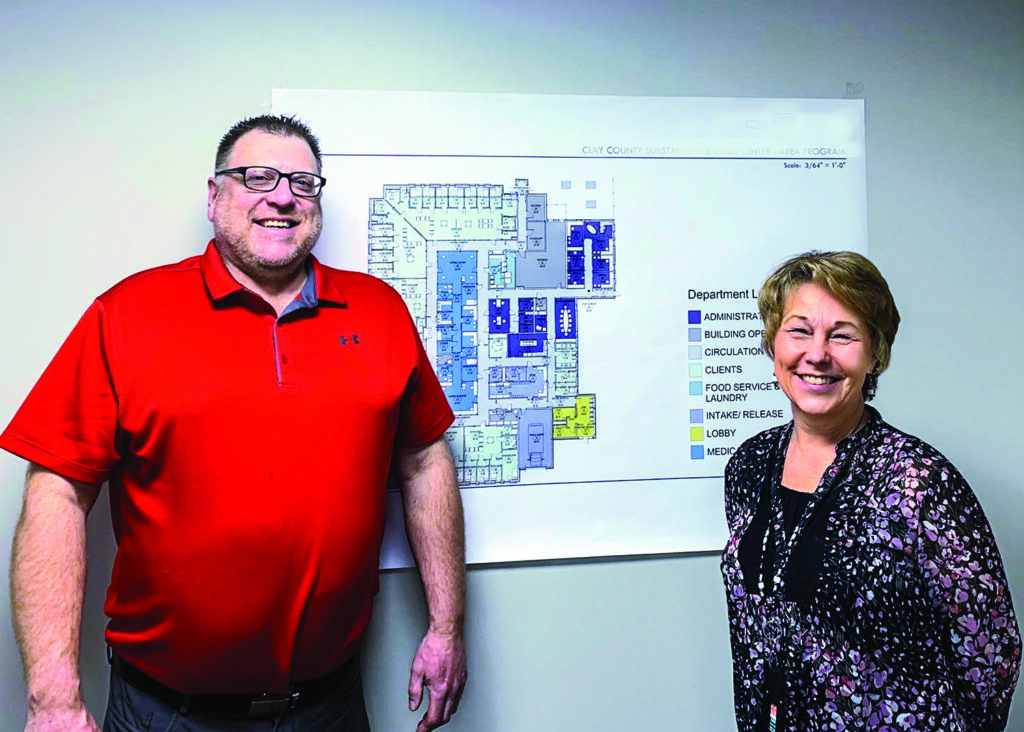Nancy Edmonds Hanson

Detox Unit director Troy Amundsen and Public Health administrator Kathy McKay look forward to the new Substance Abuse Crisis Facility, with construction slated to begin this summer. (Photo/Liz Bjur.)
Clay County took a bold step 50 years ago. Faced with a growing number of alcohol and drug users in crisis, the county commission set up one of out-state Minnesota’s earliest programs to help them safely come down from levels of intoxication that threatened their health or even their lives.
The need for emergency care to manage extreme intoxication has grown over the years. Today the Clay County Detox Unit is always busy, managing the withdrawal process for those with dangerous levels of drugs or alcohol in their systems.
Extreme intoxication is dangerous, Detox Unit director Troy Amundsen explains, especially in the hangover period when the brain is dehydrated. It also disrupts sleep patterns, another common trigger. Staff at the detox unit can administer medicines, like naltrexone, that prevent seizures. They also keep an eye on those who are admitted until they can safely return home.
Housed on the second floor of the Family Service Center at 715 11th St. N., the unit is staffed by two registered nurses, five LPNs, three technicians and a licensed alcohol and drug counselor. The medical director, who is an emergency room physician, is available under contract for consultations.
Back in 1973, the ground-breaking Clay detoxification program amounted to “a couple of beds in the jail,” Amundsen says. It moved from the jail to its present location when the county purchased the closed St. Ansgar Hospital facility 30 years ago; the number of available beds has fluctuated between 10 and 16 in the ensuing years.
That will soon change. The county is letting bids next month for a state-of-the-art facility to be built on 15th Avenue North west of the new Resource Recovery Center. When complete, the $15.7 million crisis center will have room to manage 32 men and women withdrawing from critical degrees of substance over-use.
“This is a place to get help, not punishment,” the director explains. “It’s not jail. We feel it’s one step down from being admitted to a hospital. We’re partners with the emergency departments at Sanford, Essentia and the Veterans Administration. We provide medically supervised care to those who need it, but at a lower cost than hospital admission.”
Individuals arrive at the door of the Detox Unit in several ways. Some — about 40%, Amundsen estimates — are brought there for help by law enforcement officers. Another 25% admit themselves, fearing the seizures and other complications brought on by extreme intoxication. Ambulances may transfer some from hospital ERs. Most of the rest come through the court system through Minnesota’s 72-hour commitment hold. “They need to be in a facility until they can get into treatment programs,” he notes. The Clay County program is also one of the few in out-state Minnesota that can admit pregnant women.
Early on, according to public health administrator Kathy McKay, the county commission calculated that operating its own medical detoxification program — mandated by Minnesota law — was more cost-effective than transporting local men and women to facilities in the Twin Cities or Duluth. “Our county board has been extremely supportive of us,” she emphasizes.
But Clay County residents are not the only ones who turn to the detox unit for help. Other counties in northwestern Minnesota also count on the Moorhead program, transporting dangerously intoxicated individuals from as far away as Roseau and Marshall counties. Too, people facing withdrawal come from across the Red River. Admissions from the Fargo-based Southeast Mental Health nearly equal the number of Clay County residents the unit serves. Their care is covered by the North Dakota agency. Minnesota counties pay for services received in the Moorhead facility; Medical Assistance and private insurance also cover some of the cost for qualified individuals.
With the need growing, McKay and Amundsen began looking for funding a replacement for the program’s cramped, inconvenient location several years ago. “We applied to the state Department of Human Services for a grant twice,” McKay recounts. “We were approved for a $5 million behavioral health award in 2019, but it was delayed until early 2022.”
That grant enabled the commission to give the go-ahead to design the new substance abuse recovery center. Construction is expected to start in late spring.
Amundsen is looking forward to replacing group accommodations now in use at the Family Service Center with the 32 private rooms that will be housed in the new center. The present four wards each contain from two to five beds, totaling 16. The proportion of males and females, though, often makes it impossible to admit the maximum on a given night. The set-up precludes any degree of privacy and complicates communication with the medical staff and addiction counselor.
“We have 5,000 square feet now. The new building will have 21,000, along with an enclosed outdoor area,” he points out. “The need is already here. When this project is complete, we’ll be able to provide more help for everyone who needs it.”
McKay adds, “Substance abuse is a disease — a disease that can be life-threatening. We can’t even imagine the degree of trauma some of these people have experienced. When the project is complete, we won’t have to turn anyone away.”


